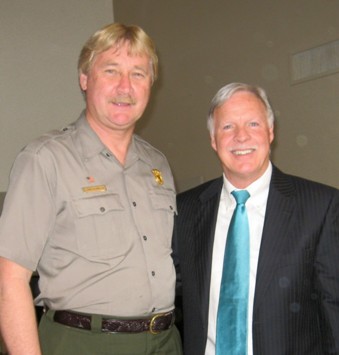



 By: Shirley Jefferis Essary By: Shirley Jefferis EssaryTed Hillmer, Superintendent of Wilson’s Creek Battlefield, shared the stage with Bertram Hayes-Davis, a descendent of Confederate President, Jefferson Davis, and a distant cousin to President, Rutherford B. Hayes. Both spoke at the Cherry Blossom Festival on Friday. Hillmer, who has worked for
the National Park Service for 31 years and has a background in Civil
Engineering and Environmental Science, has both Bachelor’s
and Master’s Degrees from the University of
Oklahoma. He became superintendent of Wilson’s Creek in 2003.
Hillmer discussed the
profiles of the Generals who led the troops that fought at Ft. Sand
Springs, an old Indian Fort northeast of Marshfield on January 9, 1863.
This fort which sat on the Old Wire Road was the first of
three forts to fall to Confederate troops in just a few days’
time. The Fort at Marshfield fell shortly after Sand
Springs and the Fort at Hartville, although able to mount a stronger
defense, fell after Marshfield. Confederate General, John
Sappington Marmaduke, was wounded in the Hartville
Battle as he and his troops were making their way back to Arkansas.
Marmaduke
was the Confederate Commander of the troops raiding Missouri
in 1863. He grew up on a plantation in Saline County, Missouri. His
father was the 8th Governor of
Missouri and his great-grandfather was Governor of Kentucky
from 1832-1834.
Marmaduke’s father
was an avid Unionist but his uncle, Claiborne F. Jackson was a
“pro-secessionist” and the current Governor of
Missouri when he appointed his nephew a Colonel in the State
Guard. When his uncle insisted that he attack Union General Nathaniel
Lyon at Boonville on June 17, 1861, Marmaduke realized
his troops were ill-prepared to make a stand. Lyon’s
1700 troops made quick work of Marmaduke’s forces. The
Unionists called the battle “the Boonville
Races” since the Confederate Troops broke and ran
after just 20 minutes of battle. After the civil war, Marmaduke was
elected as Governor of Missouri but died in office like his
great-grandfather (Governor of Kentucky). He is buried in Jefferson
City.
Union
General, Benson Brown, moved to St. Louis in 1852 from Ohio. He was
active in the movement that held Missouri to the Union. He was the
Acting General on the defense of Springfield in 1863 where he
was
wounded and lost the use of one arm. Brown’s primary command
duties
involved suppressing Confederate guerrillas and opposing
Confederate
raids out of Arkansas and the Indian Territory. He died in West Plains
on February 11, 1902 and was buried in Cuba, Missouri next to
his wife
who died four years earlier.
The Battle of Fort Sand
Springs was a small battle, in historical terms. The end result was the
burning of the Fort by Southern Troops. Local Oral History says
that Union soldiers killed during the battle were buried at
Timber Ridge Cemetery just to the west of the Fort.
After Hillmer’s
talk, Sally Bueno with the Daughters of Union Veterans of the Civil War told the group that her
group would be placing a marker at the corner of west 38
Highway and Timber Ridge Road next year marking the battle that took
place at Fort Sand Springs. Bueno’s Hartley and Jackson
relatives both fought for the North in the battle. She asks
that anyone who comes across any Civil War Markers contact her group as
they are trying to document all markers in Missouri. The great-great-grandson of
Jefferson Davis, Bertram Hayes-Davis, grew up in Colorado Springs,
Colorado where his grandparents (Jefferson Davis’ daughter
and son-in-law) settled after the Civil War. Currently living
in Dallas, Texas, where he is a banker, Hayes-Davis talked about his
famous relative from Mississippi and noted that Jefferson
Davis descendents travel from all over the country each year to
“mingle beneath the cedars and oaks of Rosemont Plantation
“near Woodville, Mississippi to tell tales, and to
reminisce. Their purpose is to celebrate the birthday of a relative who
helped shape the
destiny of the South--Jefferson Davis, who
was the president of the Confederacy.
Jefferson Davis’
first wife was Sarah Knox Taylor, daughter of Zachary Taylor, the 12th President of the United
States. She died at age 21 and Davis later married Varina Banks Howell
who lived to be 80 years-old and died in 1906 in New York City.
With
no surviving sons, Varina Banks Howell Davis and other relatives asked
her 8 year-old grandson, Jefferson Addison Hayes, if he would be
willing to change his surname to “Hayes-Davis” so
the Davis name would
continue. Hayes-Davis told the audience that the Davis’
being, well
Davis’, did not merely file a petition to change little
Jefferson
Addison’s name but, instead, went to the Mississippi State
Legislature
and had them issue a proclamation changing the child’s name.
He says
that his grandfather carried around the proclamation for years in his
wallet as did his father.
Hayes-Davis said that he was
told that Hurricane Katrina had destroyed Jefferson Davis’
last home in Biloxi, Mississippi four years ago but found out later
that while the Museum was totally destroyed the home named Beauvoir was still standing. Extensive
repairs were made to the structure, which has been used as a memorial
to Jefferson Davis and the Confederate Soldiers since 1903. It was
re-opened to the public on June 3, 2008 (The 200th birthday of Jefferson Davis).
|